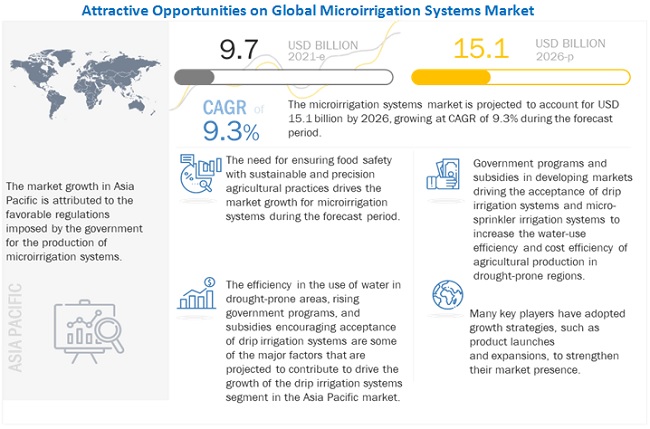The global microirrigation systems market size is estimated to be valued at USD 9.7 billion in 2021 and is expected to reach a value of USD 15.1 billion by 2026, growing at a CAGR of 9.3% in terms of value during the forecast period. Factors such as growing commercial agriculture, higher yield requirement from the limited area of land, and the increasing production of fruits & vegetables through greenhouse agriculture methods. Microirrigation systems are being increasingly implemented by farmers in regions of high-water scarcity. These are some of the factors driving the growth of the microirrigation systems market globally.
Download PDF brochure: https://www.marketsandmarkets.com/pdfdownloadNew.asp?id=566

The market for microirrigation systems, by type, has been segmented into drip irrigation systems and micro sprinkler irrigation systems. Micro sprinklers are considered to be the most water-efficient irrigation systems. Micro-sprinkler irrigation is a low-pressure, low to medium-volume irrigation system suitable for high-value crops such as tree fruits. Micro-sprinkler irrigation saves water due to the high application efficiency and high-water distribution uniformity with little of any waste managed properly. Micro-sprinkler irrigation is ideal for irrigating sloping or irregularly shaped orchard blocks that cannot be flood/furrow irrigated. Micro-sprinkler irrigation applies water directly to the soil surface area, allowing water to dissipate under low pressure and infiltrate orchard soils in a wetted profile that uniformly meets water demand throughout the orchard block.
The plantation crops segment is projected to grow at the fastest rate during the forecast period. Plantation crops are a group of commercial crops of perennial nature, which, when cultivated extensively in tropical and subtropical situations, need the employment of labor throughout the year and the produce that is usually consumed after processing. Plantation crops are mainly artificially planted farms or forests established for commercial purposes to produce crops, particularly to cater to the international markets. Fast-growing plants such as cotton, coffee, tobacco, sugarcane, and rubber are planted in plantations. Banana plantations are the smallest orchard crop included in plantation crops in some regions. Tea is a beverage crop grown on plantations.
Over the last two decades, the irrigation sector in most countries in the Asia Pacific region has shifted its focus on the development of new irrigation systems to technology upgradation, management, and sustainability of irrigation systems. Agricultural production in the Asia Pacific region has shifted to commercial crops from traditional crops, wherein irrigation systems originally designed for grain production will have to upgrade and modernize their irrigation system management and possibly their infrastructure. Microirrigation plays a vital role as commercial crops are more sensitive to the timing and amount of water delivered. However, in areas where a shift to commercial crops has not occurred, farmers are not inclined to invest in irrigation.
Make an Inquiry: https://www.marketsandmarkets.com/Enquiry_Before_BuyingNew.asp?id=566
This report includes a study on the marketing strategies and the product portfolios of the major companies that operate in the microirrigation systems market. The report has leading company profiles such as Jain Irrigation Systems Limited (India), Netafim Limited (Israel), The Toro Company (US), Lindsay Corporation (US), EPC Industries (India), Nelson Irrigation Corporation (US), Rain Bird Corporation (US), T-L Irrigation (US), Hunter Industries (US), Rivulis Irrigation Ltd (Israel), Chinadrip Irrigation Equipment Co., Ltd. (China), Elgo Irrigation (Israel), Antelco Pty Ltd (Australia), Microjet Irrigation Systems (South Africa), Irritec (US), Metro Irrigation (India), Irritec S.p.A. (Italy), Irrigation Direct Canada (Canada), Drip Research Technology Solutions (Turkey), DripWorks Inc. (US), and Raindrip, Inc. (US).